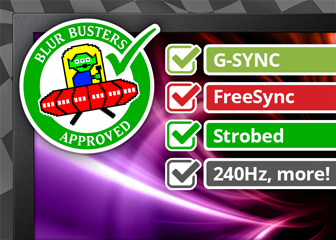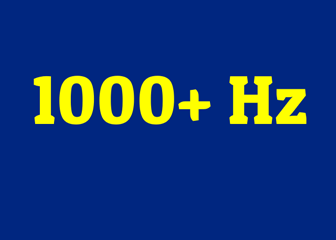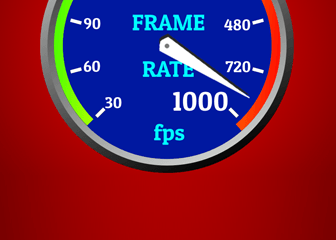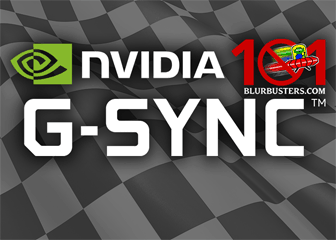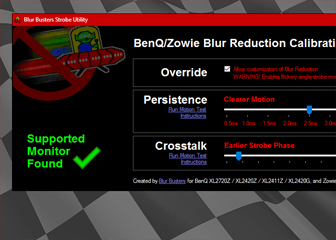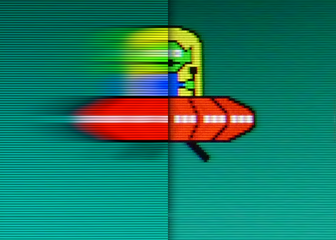After combining all the crosstalk reduction tricks and QFT we get significantly improved motion clarity. The lower the refresh rate, the more time for GtG to settle, therefore more crosstalk is disappearing. 60 Hz really is next level. Practically a simulation of zero-GtG display, with zero crosstalk across whole panel (OLED-like). On top, one can choose any MPRT they want. At 120 Hz some double imaging is starting to appear, but still very tolerable. 240 Hz at the very center is impressive, but as GtG and backlight can’t keep up, top and bottom thirds show more crosstalk than low refresh rates. At this point in time strobing on LCD is more suitable for lower refresh rates! Preferably 60 for retro, ~120 for casual, 240 for esports.
Excellent motion performance of low refresh rates is restrained by brightness, while at high refresh rate panel can’t keep up. This puts XG2431 in a weird position. We are left with crosstalky 240 Hz at reasonable brightness, and with perfectly clear, but dim 60 Hz. However, certain brightness can be sufficient/insufficient depending on personal preference and lighting conditions, so your mileage may vary. Some might find 120 Hz a good balance between clarity-brightness-latency-flicker. I’d say if you regularly consume 60-120 fps content, and brightness is not an issue, and you eye-track a lot, PureXP is a perfect choice.
The lack of automation makes PureXP less user friendly. QFT can be difficult to understand or create, and Custom settings are hard to nail for average user. It requires a lot of tinkering and research to do correctly. It is most likely complicated for advanced users, let alone inexperienced. This is confirmed by some of the reports online of unsuccessful QFT attempts. In theory all the settings can be, and should be automated.
Suggestions
For future versions of PureXP, ViewSonic and Blur Busters should consider new set of requirements:
- optional automatic QFT, for any refresh rate/resolution combo
- optional automatic overdrive, for any refresh rate (e.g. with gain multiplier that simply offsets factory tuned range, multiplier on top of multiplier)
- optional automatic pulse phase for best quality and possibly best latency at screen center, for any refresh rate/pulse width/vertical total combination
- minimum brightness, e.g. fixed pulse amplitude of 1000 nits (~120 nits at 2 ms MPRT for 60 Hz), ideally much higher
- plenty of GtG compliance
The requirements for ideal strobe mode would normally be much more stringent, but due to current technological limitations, some parameters are unattainable.
There are other barriers and pitfalls to strobing – no variable refresh rate support. A general rule for ideal motion smoothness, just like with standard sample & hold modes, is to have a perfect frame time synchronization between gpu and the display. If the two are not matching perfectly there will be visible artifacts such as screen tearing, micro stutters/jitter and blur doubling. Blur reduction modes amplify some of these as there is less motion blur to hide it. This means strobing would benefit from VRR more than sample & hold mode.
Easiest way to fix this is with vsync. In order for Vsync to maintain a consistent frame time cap with no dips, gpu needs to be able to push frame rates notably higher than refresh rate. But a known issue is that Vsync adds 1-2 frames of latency when frame rate crosses the vsync threshold, which can be a big problem depending on the refresh rate. For that reason most people avoid vsync.
A known workaround is very precise frame time capping (low lag vsync) with third party software such as Guru3D Rivatuner Statistics Server (RTSS) or similar. I personally found this solution not ideal either. It requires a lot of tinkering to make it work while still being prone to desync and occasional stutter, and it still added perceivable amounts of latency (Hz dependant), although less than standard vsync. Properly set up VRR strobing would still be lower lag than low lag vsync and much more user friendly.
All in all strobing works, but there are caveats.
